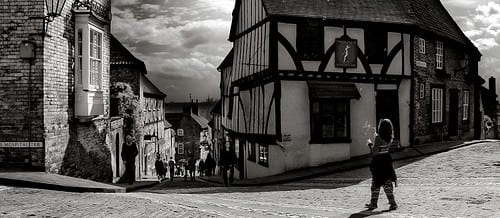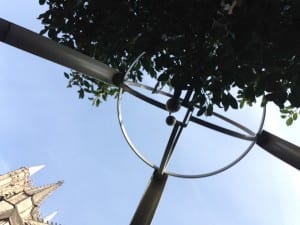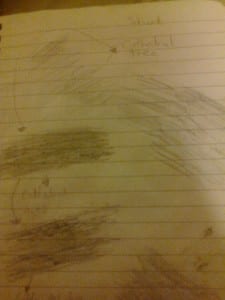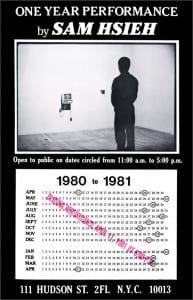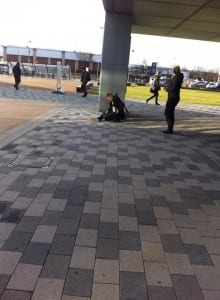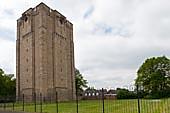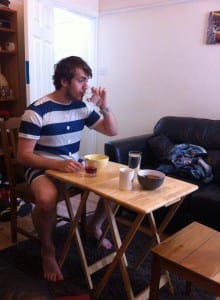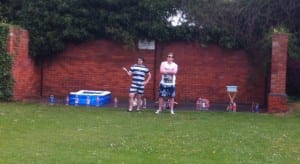Framing Statement
For my groups Site Specific performance, our group decided to create an audio walk for our audience to listen to while exploring Castle Square and its surrounding areas. For me, I believe that our main inspiration for wanting to do an audio walk came around after learning about the work of Janet Cardiff. While working alongside George Bures Miller, Janet Cardiff’s audio walks all over the world were the main inspiration for us to create our own audio walk in Lincoln. We were initially drawn to the idea of creating a site specific performance that would seem normal but, throughout the walk, having disruptive sounds playing and different integers in the audio. Janet Cardiff did something similar to this when she created and audio piece which consisted of having loud, obnoxious noises being played while the people listening to it were situated in the middle of a calm forest, an extract of which I will link here: https://www.youtube.com/watch?v=hGqPwaZVPBo
In the end, after much discussion and alterations, our group decided that our audio piece will be
Our final performance took place at Newport Arch and took the audience down to Castle Square and then to the cathedral through Exchequer Gate. We also decided that, just to be safe, our group would be scattered along the audio walks route so that, if any of the audience did not know which way to go next or if something went wrong with their audio, they could come over and ask us for help. We decided to have the audience start the walk and then end it by walking through arch ways as they were used to symbolise entrances and exits. Also, in the roman era, Newport arch was the official entrance to Lincoln. It took place between two and four in the afternoon. The audio itself would take eleven and a half minutes to listen to. We decided that it would give the audience a better experience if they started the audio walk at separate times. If the audience were to walk all together, it would lose most of the impact we would want them to experience. If they went on the walk by themselves, on in pairs if they wanted to, it would free them up to walk the walk at their own pace and, hopefully, this would create a more enjoyable experience for them.
Analysis of Progress
According to Mike Pearson: “Site Specific performance exists within a plethora of phenomena, all competing for attention, all potentially meaningful: A concatenation of that at site and that brought of the site”. Meaning that the performance and the staging area you decide the performance will take place are interlinked in this style of performance much stronger that they would be in any other form of performance work. In other words, it is possible to perform the same site specific piece in hundreds of different locations and have the meaning of the performance be perceived differently in every single location.
In our first lesson of Site Specific, we were introduced to what Site entails and some of the performance types that are included in the category “Site Specific”.
We all took part in what is known as a “Subtle Mob” which is like a Flash Mob but, where a Flash Mob is big, bright and noticeable, a Subtle Mob is often unnoticed by many of its “audience”. We followed a list of instructions such as look at the sky, take a photograph, copy a stranger’s walk etc.
This allowed us to get a beginners understanding of how Site Specific works because, if we had followed these instructions anywhere else, the end result would have been different depending on which location we chose.
In our recent lesson, we got to see the site(s) we will be performing on and got told some of the background for the site(s). While we walked around, we learnt more about ideas we could use in our performances. Many people began to piece together what they wanted their own performances to look like.
I, myself, have found some points of interest that have intrigued me.
I haven’t got a fully fledged idea in mind yet, but the pieces are coming together and I hopefully will soon.
In our third site lesson, we were given more freedom to explore and interact with the site on our own. We had to create an “unusual” map of an area and lead our classmates on a misguided tour.
For the map, my friend Charlie and I decided to create a map of texture rubbings from different buildings all around the site. we did this because everyone comes from different backgrounds and experiences these places differently but, when you get down to it, these places are more similar than you think :‘To see the city from one’s bed, from one’s bath, from one’s rooftop – how perfect to live in a city.’ (Etchells, 1999, 76-80)
We then had to create and lead our class on a misguided tour and a small area of our site. Charlie and myself decided to be historical researchers doing a tour of a well where, in the nineteenth century, a killer used the well to hide bodies. We told the class that the memorial next to the well had the names of all the victims that the police found on it. ‘Playing always to the different histories written in urban space – the official historical, the personal, the mythical and the imaginary.’ (Etchells, 1999, 76-80)
While taking part in these activities, ideas began to form in my head about what I could do for my site performance. Hopefully soon they will be more solid.
Seeing as site specific can also be altered by time as well as the place, I decided to explore the site at night time to see if anything in the site changes.
As you would expect, many aspects of the site changes at this time such as the Cathedral is much brighter as it is lit up
Here are the pictures I took that night: https://flic.kr/s/aHsk4Z6mP6
Two pictures that stood out to me are: 1) The picture showing the Cathedral from the furthest point up the hill that you could see it from and 2) The “Secret Pathway” that our tutor showed us a few days before during lesson
These two stood out to me because they are both rather striking and both taken from the same standing point (just 180 degrees in different directions) show that things can be different depending which way you look at it
Our groups’ original idea for the audio walk was to have people start in front of the cathedral look at Exchequer Gate. Then, we would walk them through the middle arch which we had called the “Life Arch”. We would then split them into two groups and then lead them back through the other two arch ways which we had decided to call the “Heaven Arch” and the “Hell Arch”. We would have then given the “heaven” and “hell” groups’ two different variations of the audio for them to listen to while they walk around the cathedral and end up at the Tennyson monument (The “hell” group going around to the left of the cathedral and the “heaven” group going to the right). Another way in which the two groups would have differed from each other was that the “heaven” group would listen to soothing sounds such as hymns, bird songs etc. We also chose for them to circle around the cathedral to the right because that is where it is possible to see the sun as the cathedral is not blocking it, therefore they would have sun light shining down on them. Whereas, with the “hell” group, we wanted them to have to focus slightly more on the audio of the audio walk. We had planned on giving them a large blindfold to put on as they walked around the cathedral. We would then make them listen to no so nice sounds like fire crackling in the background, distant screams, angry voices etc. However, when we explained to our tutor what our plan was, she told us that she believed that we were spreading ourselves a little bit too thin with the amount of ideas that we had brought forward. She also mentioned that it was possible that some of our audience members might get the wrong idea by our concept of giving people a black ‘veil’ to wear while they were walking with the “hell” group. We, of course, decided to have a rethink of what we wanted our performance to be.
Our groups’ new, updated idea for the audio walk was still to have our participants split into two groups (we did this because we liked the idea of giving our audience two separate and opposing experiences that they could talk about with each other after the audio walk was over).
Our idea for the separate audio tracks this time was to have one of them listening to our own take on the 1185 earthquake that cause the cathedral to collapse while walking up the hill towards Castle Square and then further to the cathedral itself. While doing this, we were going to have them listening to sounds of the town (as it would have sounded in 1185) such as horse and carriages, market sellers, general hustle and bustle etc. however, as they get further up the hill and closer to the cathedral, the sound effect of an earthquake in progress will gradually get louder and louder so that, when the audience reaches the front of the cathedral, the earthquake is in full force. Then, we would walk them around the cathedral while listening to the aftermath of the destruction and end outside of the Chapter House.
While that is happening, the other group is listening to sounds of planes, guns, marching, music from the 1940 etc. This will be our representation for the Lincoln R.A.F base and their contribution to the war. We were going to start this group in front of the war memorial by the entrance of the castle. We would then slowly walk to the cathedral listening to the army sounds as they turn from “training camp” sounds into “fully fledged war” sounds. They would then walk around the cathedral (The opposite way to the other group), all the while still listening to war sound effects.
When both groups reach the outside of the Chapter House, they would then line up opposite each other and there would be some type of interaction between the two of them. We always believed that our audio walk should slowly lead up to ‘a moment’ which would surprise the audience. What the moment would have been in this version of the audio walk we did not think of at this time.
When we showed this to our tutors, they, unfortunately, were not as enthused at the idea of this style for our audio walk as we would have hoped. They told us that they enjoyed the earthquake side of the performance idea but were not as keen at the R.A.F side of the performance, because the R.A.F base that is located in Lincoln was not anywhere near Castle Square so it did not made much sense to create an army audio walk if it had nothing to do with where our site was.
When our tutors put our idea in that light, it did seem like a bad idea. So we decided to continue down the earthquake idea.
As we were told that we should proceed with the idea of having the audio being centred around the earthquake, our group decided that we should do some research into the actual earthquake that happened in 1185. Unfortunately, when we went to the public library to search for any information, data or journal articles about the earthquake, we found next to nothing on the event. As it turned out, many documents from that time were destroyed shortly after the cathedral collapsed.
However, we did manage to find a letter that someone sent out to ask for any new information that people could offer in regards to the disaster. We decided that this would be good to use in our audio by having someone read it out loud in the audio after the earthquake had hit.
Some of us also decided to have a look down the high street past the cathedral to see where would be best to have the audio walk take place. After looking around, we decided that we would have the audio walk start at Newport Arch, follow the high street down to Castle Square and then go through Exchequer Gate and end in front of the cathedral.
When we spoke to our tutor about our idea, she thought it was a really good idea and encouraged us to carry on with our idea.
I never realised how hard it was to make something sound natural. As I am in charge of the audio for the walk, it is my job to make sure that all of it sounds natural and flows seamlessly. One of the major problems that I faced while recording/editing the audio was the wind. Because whenever we recorded the audio it was always very windy in Lincoln, the microphone easily picked it up. I did not realise until I was editing the recording just how disruptive the wind was being. I ended up having to cut out the really bad spikes of wind and just try to make the audio sound natural without it. Another problem that occurred during the editing stage was creating the final earthquake sound. Whatever I did and where ever I looked, I could not find an earthquake sound effect grand enough to finish our audio piece, and the ones that were grand enough did not turn out well coming out of headphones. In the end, I had to take audio of different natural disasters (A volcano, a forest fire, a tornado and a landslide) and mix them together to try and make a convincing earthquake sound effect. I also had problems with the earlier rumbles. When editing, I had to add in some rumble sounds to build up to the end earthquake sound and have more of an impact. However, even though while editing, I was able to clearly hear the rumble effects, when I sent it to the rest of the group, they told me that they could not hear any of them. We decided this was because of the fact that the sound effect sounded a little like wind in the background. I could hear them fine because I could see where they were and knew when to expect them whereas the others did not. To fix this problem, all I had to do was turn the volume of the rumbles up to higher than I believed necessary and everything was fine.
In the end, I am very happy with the way the audio has turned out and hope that everyone that comes to our show thinks the same. I have attached the audio so that people can have a listen.
Performance Evaluation
In the end, I believe that our final performance went rather well. Unfortunately, we did not get as many participants as we would have wished as we only had two of our tutors who were marking the performance and three of our friends. Another piece of bad luck that we received was that the weather was very bad that day. There was a lot of rain which, I believe, is what stopped many people from coming to our performance. However, regarding the people who turned up and took part in our audio walk, they were very willing to go along with the walk and did not try to ruin it by messing around. While the audio walk was in process, I had a few ideas about, if we had to redo the module again, what I would change to help improve our performance. Firstly, I would have the guide that were scattered around the walks route wear clothes or accessories that were much more recognisable when searching for them. I realised while performing that we were wearing clothes that were too normal and the audience, if they needed help, would not have seen us as easily. Another thing that I would change if I had the chance would be that I would add more technology to the performance. One of the worries that our group had while testing the audio is that it relied too heavily on our audience getting to the cathedral in just the right amount of time. If we had the technology, I would have given each audience member an mp3 player with the audio on that would only play background noises and, when they go under Exchequer Gate, only then would it start playing the earthquake sound effect. Taking part in this module has helped me to understand site specific a lot better. As I started out as someone who had never even heard of this style of performance before this, it is good to see that my knowledge of different styles of performance has grown.
Bibliography
Pearson, M. (2010) Site-Specific Performance. London: Palgrave Macmillan.
Murphy, G (2015) George Murphy’s Flickr [Online] Flickr.com Available from: https://www.flickr.com/photos/129670756@N08/sets/with/72157648515913843
Murphy, G (2015) Georg Murphy’s Soundcloud [Online] Available from: https://soundcloud.com/george-murphy-101/disturbance-audio-walk
